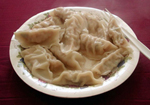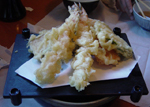-
Chawanmushi: Egg custard appetizer with dashi,
diced vegetables, chicken or seafood. Chawanmushi translates to
"steamed in a tea bowl" or "tea cup steam."
-
Chazuke (Ochazuke): Bowl of cooked rice
with green tea and a variety of other toppings to preference,
such as cooked eggs, nori (seaweed), poultry, savory seasonings,
seafood, sesame seeds, tofu or vegetables.
-
Congee: Soup or
porridge made with egg, meat, rice, seafood or vegetables stewed
in stock.
-
Donburi:
A single bowl of rice topped with pork, chicken, seafood or
vegetables.
-
 Gyoza: Japanese dumplings (pictured at right;
click on image to view larger size in a new window). Fillings can vary but usually contain meat. Gyoza can be
pan-fried (guotie), boiled (shuijiao) similar to broth dumplings
or steam-cooked (zhengjiao).
Gyoza: Japanese dumplings (pictured at right;
click on image to view larger size in a new window). Fillings can vary but usually contain meat. Gyoza can be
pan-fried (guotie), boiled (shuijiao) similar to broth dumplings
or steam-cooked (zhengjiao).
-
Gyudon: Bowl of
rice topped with slices of cooked beef.
-
Hayashi Raisu: Beef
stew hash.
-
Hiyashi Chuka: Chilled ramen
noodles served with carrot, chicken, cucumber, strips of cooked
egg, ginger, ham or barbecued pork; topped with tara
sauce (rice vinegar, sesame oil and seeds, soy sauce and sugar).
-
Kamameshia: Rice
pilaf cooked in a pot with meat, seafood and vegetables; also
known as "kettle rice."
-
 Kare Raisu: Rice cooked in a curry
sauce. A variation of
Curry Stew (Kareh Raisu).
Pictured at right (click on image to view larger size in a
new window).
Kare Raisu: Rice cooked in a curry
sauce. A variation of
Curry Stew (Kareh Raisu).
Pictured at right (click on image to view larger size in a
new window).
-
Kasutera:
Sponge cake made with warm milk, honey and bread flour.
-
Kayu: Rice gruel,
similar to oatmeal.
-
Kinpira gobo:
Stir-fried burdock and other root vegetables; served with sweet
soy sauce.
-
Korokke: Similar to a
croquette.
-
Kurimu
Shitu: Creamy stew with western influence (yoshoku).
Made with cabbage, carrots, chicken or pork, potato and mixed
vegetables; cooked in a white roux.
-
Kushiyaki: Seasoned
meat and vegetables cooked on skewers.
-
Misoshiru (Miso Soup): Clear soup made with
miso paste and dashi; usually contains spinach and tofu.
-
Motoyaki: Baked
seafood in a cream sauce.
-
Motsunabe: Beef
offal, cabbage and other vegetables cooked in soup.
-
Nabe: Hot pot meals.
-
Natto: Fermented soy
beans.
-
Negimaki: Broiled
strips of beef marinated in teriyaki sauce and rolled with
scallions.
-
Nikujaga: Meat and potato dish.
-
Noodles: Noodles are almost as popular as rice. Some of the
different types of noodles are Soba, Udon,
Ramen and
Somen.
-
Oden: Nabe dish
including fish cakes, eggs and vegetables cooked for hours in a
soup.
-
 Okonomi Yaki:
Cross-between pizza and a pancake; usually made with vegetables.
Pictured at right (click on image to view larger size in a
new window).
Okonomi Yaki:
Cross-between pizza and a pancake; usually made with vegetables.
Pictured at right (click on image to view larger size in a
new window).
-
Omuraisu: Cooked rice wrapped in a thin omelet; typically
served with gravy or ketchup.
-
Rice: The
basic foodstuff of Japan. Rice is eaten for breakfast, lunch and
supper. For more, see Japanese Rice
section.
-
Sashimi: Raw fish
sliced very thin; served with various dipping sauces.
-
Sekihan: Rice cooked with red azuki beans; traditional
dish with a reddish hue that can be sweet or savory.
-
Shabu Shabu: Beef,
tofu and vegetables cooked in stock and served with sesame or
soy-based sauce.
-
Shogayaki: Pork
flavored with ginger.
-
Soki: Pork stewed with
bone.
-
Sukiyaki: Beef, tofu and vegetables cooked in a pot and
then dipped in raw egg.
-
Sushi: Vinegar-seasoned rice topped
with vegetables or raw fish. For more, see Sushi
section.
-
Takiyaki: Fried
octopus dumpling.
-
Tecchiri: Blowfish
and vegetables in a hot pot; common to Osaka.
-
 Tempura: Seafood
and vegetables deep-fried in thin batter. Pictured at right (click
on image to view larger size in a new window).
Tempura: Seafood
and vegetables deep-fried in thin batter. Pictured at right (click
on image to view larger size in a new window).
-
Teriyaki: Broiled,
grilled or pan-fried beef, chicken, fish, pork or vegetables
basted with a sweet soy sauce.
-
Tofu: Soy curd.
-
Tonkatsu: Deep-fried pork cutlets.
-
Yakisoba: Deep-fried noodles served with meat, vegetables and
ginger; Chinese origins.
-
Yakitori: Grilled chicken on skewers.
-
Yakizakana:
Flame-grilled fish.
-
Yosenabe: Seafood and
vegetable soup.
-
Zosui:
Soup made from pre-cooked rice and water.